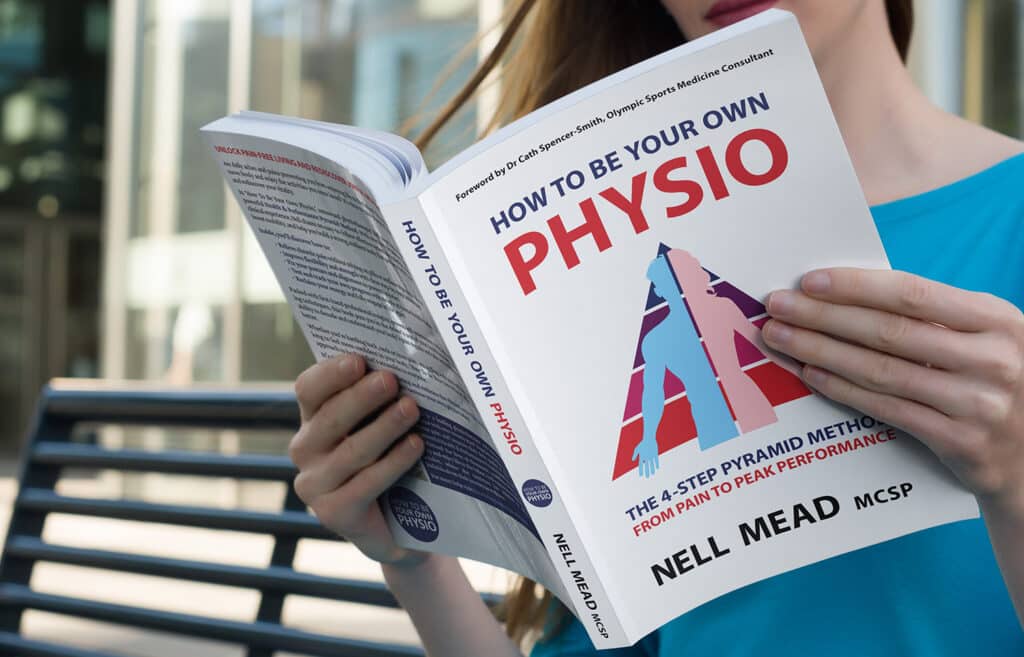How to prepare for a hip replacement surgery
The BBC recently reported that the waiting list for routine surgery in England could hit 10 million by the end of this year. This is likely to include over 100,000 patients waiting for hip replacement surgery. I was recently quoted in the Daily Mirror providing some exercises to help people awaiting hip replacements but thought it might be useful to go into a bit more depth here. I’m going to start with some general (but important!) information about hips and hip replacements, and then explain what you can to do prepare yourself.
Tell me about hips
The hip is a ball-and-socket joint that connects your torso to your legs. Surprisingly, it’s much closer to the groin than most people think. Most people imagine they can touch their hip by touching their outer thigh, but if you’re doing that, you’re way off – instead, find your groin crease, and the actual hip joint is about half way between the top of your pelvic bone and your groin. The “ball” is formed by the top of the femur (thigh bone) and the “socket” is formed by the acetabulum, part of the pelvic girdle.
The hip is designed to be a very mobile joint, able to move in a lot of different directions. This allows us to walk, run and sit, but also to twist, change direction, crouch and kick. Our hips allow us to adapt to uneven ground, and to perform high kicks and arabesques like a ballet dancer or a gymnast. Hips can do this because the ball and socket are quite shallow, allowing lots of range.
The hip also has to be a very stable joint, as it has to carry our body over our leg and transfer load. It also has to absorb shock when we land hard. The hip can do this because the ball is held in place by strong ligaments and a fibrous joint capsule; and because the ends of the bone are coated in hyaline cartilage, which helps it to glide and absorb shock.
We have lots of muscles that move and support the hip joints, pulling the bones in different directions. Some muscles are designed to help us control the way the ball is centred in the socket and help it to stay healthy, and others are more focused on producing movement.
Why might I be told I need a hip replacement?
These days, we are able to replace hip joints when they are not fit for purpose. This could be due to an accident (for example, sometimes if you fracture the femur in the wrong place, you lose blood supply to the “ball” so it can’t recover and needs to be replaced) but more commonly, it’s due to osteoarthritis.
Osteoarthritis is essentially “wear and tear” to the hyaline cartilage that coats and protects the ends of the bones – both the ball and the socket of the hip. There are many ways in which this cartilage can be damaged, including:
- trauma: for example, an old fracture in the hip joint, but one in which the blood supply was not damaged so that the bone could repair itself
- overuse: this is very common in people who’ve played a lot of rugby and football as these sports require a lot of twisting, turning and contact, which place stress on the hip
- underuse: couch potatoes and workaholics who sit in the same position all the time can create joint stiffness and “wear points” where the same area of cartilage is constantly under strain
- misuse: for example, I recently wrote about my patient Bella, who developed hip problems after suddenly doing a lot of exercise despite having poor muscle control
Osteoarthritis can be the outcome of any one or more of these issues.
I also think lockdown has affected a lot of hips: we’ve mostly spent this year either sitting or walking, which involves a relatively small range of movement for the hips and only in one plane, rather than the movement variety that sporty people’s hips are used to getting when we twist, turn, crouch and change direction. I’m certainly seeing a lot of people with hip pain at the moment, and I believe this is a big part of the reason.
Having said that, most of us over the age of about 30 are walking around with some degree of osteoarthritis somewhere! Just because you have some wear and tear in your joints, it does not automatically mean that you need a joint replacement. I was diagnosed with arthritis in my right shoulder when I was 24 (too much tennis) but despite continuing to play tennis at a reasonably high level, the arthritis has never caused me any trouble. I certainly do not need a shoulder replacement!
I do not believe you should be offered a joint replacement unless you have joint damage combined with pain and/or loss of function, which cannot be controlled through conservative means, and which is interfering with your quality of life.
How do I know when it’s the right time for me to get a hip replacement?
To quote top sports doctor and hip specialist Cath Spencer-Smith,
“Age doesn’t determine the need for a hip replacement – symptoms do. If you’ve got pain and rubbish function, and you’ve done a heap of rehab and still aren’t getting better, it may be the right choice for you.”
Making the decision can be a bit of a balancing act. Assuming your hip replacement is elective (ie you are choosing to do it, rather than having the decision taken out of your hands by trauma) then you don’t want to have one before you need it, or while there are still benefits to be achieved through rehab, or while your hip is compensating for an issue elsewhere in your body. If your hip is compensating for something else before the operation, that won’t change when you get a new hip. Sort out any compensation patterns with good physiotherapy before you have hip replacement surgery!
However, you also don’t want to wait until the hip pain is so severe that you can’t move. If you wait until you literally can’t hang on any longer, then not only are you wasting the new life a hip replacement could have given you, but you will lose strength, which will make your post-operative rehab more difficult.
This is ideally where you, your surgeon and your physiotherapist will be communicating with each other to help you come to the right decision for you.
Does it matter where I go for my hip replacement?
In short – yes, especially if you have an unusual-shaped hip.
As I wrote in a recent blog post about a patient of mine who returned to running after his hip replacement, hip replacement surgery has made great strides over the past 20+ years since I watched it for the first time, as a physiotherapy student! Back then, all hip implants were the same shape, though they came in a few different sizes; and the planning was done with a plain X-ray. This has really changed!
Getting the right shaped implant is the most reliable way of achieving an excellent surgical result, and there are now a variety of ways to do this. It starts with taking a 3D scan of your hip, and being able to produce an implant that will fit perfectly. Modern hip implant kits come in three parts rather than the old two-piece models, and are able to be mixed and matched, to produce a greater variety of shapes and sizes; and if a mix-and-match system can’t replicate your anatomy, then it’s possible to produce a completely bespoke implant.
However, not every surgeon is trained and experienced in custom-made hip replacements, so it’s worth looking for one who is, especially if you want a higher chance of a really functional outcome (such as being able to return to sports) and if your hips are an unusual shape.
What exercises should I do to prepare for my hip replacement?
There’s no definitive list of exercises, as your body, your hip and your goals will all be unique to you. So to know and understand exactly what I think you should be doing and why, to prepare for your hip replacement surgery, you’d need to come and see me. Without seeing you, I don’t know whether your hip is trying to compensate for an old injury elsewhere in your body, or what your level of function is. However, as a baseline, I think you should be aiming for the following:
- Control: you need to be able to activate your glutes, and to dissociate between your glutes and hip flexors, as this is key to controlling the position of the ball within the socket. I get people to start lying down, so that you can “find” the muscle in isolation, and then progress to working on hip control in tasks such as standing on one foot, step forward, step up, step down and lunge. I also love using equipment such as the wobble cushion or swiss ball to help train your balance and core.
- Flexibility: the more length and flexibility your hip muscles have before the surgery, the easier it will be to use your new range of movement afterwards. Key hip movements are flexion (knee to chest), extension (stretching your leg back behind you) and abduction (moving your feet apart sideways). Don’t stretch so far that you feel acute pain in your hip, but it’s usually OK if the hip is a bit achy after stretching it: joint capsules need stretching, but that doesn’t mean they always like it at the time!
- Strength and endurance: for me, this follows on from building control. To build strength, I would get you using higher steps to step up and down from, and working on dynamic lunges and squats, potentially using weights if you can tolerate it. To build endurance, I would get you doing more repetitions (keep going for as long as you can maintain good form).
- Integration: don’t forget that your hip joint doesn’t work in isolation – it has to work with the rest of your body! I encourage my patients to use cues to integrate other body parts – for example, “floating” the head above the body, activating the pelvic floor, or bearing down through the big toe, while doing any of the hip exercises. The cues we use depend on where any other issues are showing up.
Please bear in mind that not everyone who is heading for a hip replacement will be able to do all of these exercises. Some people will find them easy, and others will find them very difficult. Work at your level – your exercises should be tough enough to be a bit of a challenge, without causing pain or despair! If you’re struggling, please do see a physio and get some individual advice – a blog post is no substitute!
What’s the recovery like after a hip replacement?
That depends on a lot of factors: the condition of your body before the operation (how well you’d managed to do with your pre-op rehab!), the type of operation you’ve had (did you have a custom-planned implant or off the shelf?), whether the operation was planned or trauma based, the surgeon (not all surgeons are equally skilled), your general health (for example, smokers and diabetics tend to recover more slowly from surgery), your age and fitness level, your genetics, your injury history… I could go on and on! Everyone’s an individual.
Most people will need days to weeks to get off crutches. My patient Russell was off his crutches in 2 days, but that’s unusual – I’ve also just started working with another patient who had a hip replacement as a result of a fall, and she’s still on crutches after several weeks.
If you’ve been given a traditional implant, you may need to take things very easy for 6-12 weeks, and use the classic raised toilet seats and chairs. Alternatively, with a custom implant, you may not! You certainly shouldn’t drive until you’ve got enough confidence in your operated leg to be able to manage an emergency stop – but again, how long that takes is variable.
In terms of rehab, unless the surgeon has provided any strict protocols, then I tend to push my patients to recover as fast and as thoroughly as possible. A lot of this is very similar to the pre-operative programme, though this time with a higher level outcome! This means getting back onto the glutes exercises as quickly as possible, and generally restoring control, confidence and balance before working on range of movement, and building up to more complex tasks, including sports if that’s part of your life plan – Andy Murray being a prime example, although I’m not sure his new hip surface will last quite as long as it would have done if he hadn’t decided to return to playing elite tennis!
We’ll also be doing some hands-on treatment to keep your joints mobile and your soft tissue supple. It’s not possible to do a hip replacement through keyhole surgery, so it’s important that your scar is mobile and able to glide over the muscle tissue underneath it.
There are occasional complications and even custom hip implants aren’t always perfect (one of my hypermobile patients did somehow manage to dislocate her custom-made hip while digging in the garden!!!) but in general, the outcomes are excellent, and as one of my patients remarked recently, “It feels like an odd thing to say when one hip is made of metal, but my running actually feels more natural now than it did before I had the surgery!”
How do I give myself the best possible chance of a great outcome?
To give yourself the best possible chance, control the factors you can control!
- Health: make sure you’re eating well with plenty of protein and lots of water. Get as close as you can to your ideal weight, avoid smoking and drinking alcohol before your operation, get plenty of sleep, and get on top of your stress levels.
- Prehab: pick a good physiotherapist who is able to look at your whole body and who doesn’t just focus on your hip in isolation. Start early so that you are really well-prepared for your surgery.
- Surgery: talk to your physio about the best surgeon for you, and then talk to your surgeon about the best operation for you. Get a second opinion if you’re not happy!
- Hospital prep: pack loose clothes to come home in! You may find socks and shoes a struggle at first – knitted trainers can come in very handy! Plan your journey home from hospital, and make sure you have plenty of healthy meals in the freezer, as you may not be comfortable cooking for a little while.
- Post-op: start your physio rehab early, and be religious about doing your hip replacement exercises long term. Maintain the hydration and nutrition (consider walking to the bathroom as part of your rehab!) You will need more sleep, so allow for that; and make sure you have help around the house until you’re comfortably off crutches. Use pain control if you need it, so that you can keep moving. And be kind to yourself – everyone’s recovery is different, and the path of rehab is rarely smooth!
Tell me the perfect hip replacement story?
In the ideal world, you’ll be working with me before having the hip surgery. We’ll do a full body assessment to work out which other areas are affecting and being affected by your hip, and we’ll rehab those before you go near a surgeon, so that you’ve got good strength, flexibility and control throughout your body.
If we then get to the point where everything else is rehabilitated and your hip is still causing problems, we’ll go to a hip surgeon who works with custom hip replacements. We’ll choose the surgeon together. They will do a 3D scan of your hip and work out the best type of implant for you.
I’ll then come into theatre to observe the surgery (the more I know about what’s happened inside your hip, often the better I can help you for the long term) and a few days later, we’ll start your post-op rehab, focusing on getting you back to whichever activities you want to be able to do.
Let me help you!
Not all hip replacements are the same. Not all hip surgeons are the same. And not all physios are the same. There are no guarantees in this life. But if you get a great hip replacement, a great hip surgeon and a great physio, then your chances of making a great recovery are much higher! If you’d like to discuss a stiff, sore hip, or plan for a hip replacement, then please call my team on 0207 175 0150 and let’s get you booked in for an assessment.







